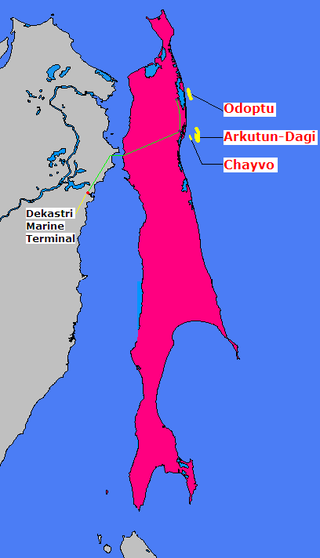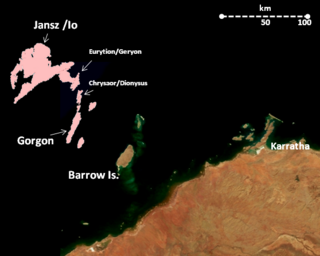
The Sakhalin-I project, a sister project to Sakhalin-II, is a consortium for production of oil and gas on Sakhalin Island and immediately offshore. It operates three fields in the Okhotsk Sea: Chayvo, Odoptu and Arkutun-Dagi.
The Tangguh gas field is a gas field lies in Berau Gulf and Bintuni Bay, in the province of West Papua, Indonesia. The natural gas field contains over 500 billion cubic metres of proven natural gas reserves, with estimates of potential reserves reaching over 800 billion cubic metres.

Bojonegoro Regency is a regency in East Java Province of Indonesia, about 110 km west of Surabaya and 73 km northeast of Ngawi. It is located in the inland part of the northern Java plain, mainly on the south bank of the Solo River, the longest river in Java. It had a population of 1,209,973 at the 2010 Census and 1,301,635 at the 2020 Census; the official estimate as at mid-2022 was 1,350,650. The administrative centre of the regency is the town of Bojonegoro.

PT Pertamina (Persero) is an Indonesian state-owned oil and natural gas corporation based in Jakarta. It was created in August 1968 by the merger of Pertamin (established 1961) and Permina (established in 1957). In 2020, the firm was the third-largest crude oil producer in Indonesia behind US-based companies ExxonMobil's Mobil Cepu Ltd and Chevron Pacific Indonesia. According to the 2020 Fortune Global 500 list, of which the company is included, Pertamina is the largest company in Indonesia.
The West–East Gas Pipeline is a set of natural gas pipelines which run from the western part of China to the east.
The South Pars/North Dome field is a natural-gas condensate field located in the Persian Gulf. It is by far the world's largest natural gas field, with ownership of the field shared between Iran and Qatar. According to the International Energy Agency (IEA), the field holds an estimated 1,800 trillion cubic feet of in-situ natural gas and some 50 billion barrels of natural gas condensates. On the list of natural gas fields it has almost as much recoverable reserves as all the other fields combined. It has significant geostrategic influence.
Human rights violations in Aceh, Indonesia occurred in the late 1990s and early 2000s when ExxonMobil hired Indonesian military units to guard their Arun gas field, and these military units raided and razed local villages. Government inquiries have extensively documented these abuses. Victims allege that ExxonMobil knew about the atrocities, which include assault, torture, and murder, and should be liable for them. The company denies these accusations; its primary defense is that the human rights violations which were occurring were not a result of specific intention of the organization and therefore it cannot be held liable.
The Makó gas field is a large natural gas field next to Makó, in southeastern Hungary.

The Gorgon gas project is a multi-decade natural gas project in Western Australia, involving the development of the Greater Gorgon gas fields, subsea gas-gathering infrastructure, and a liquefied natural gas (LNG) plant on Barrow Island. The project also includes a domestic gas component. Construction was completed in 2017.
The Kandym–Khausak–Shady–Kungrad project is a project to develop natural gas fields in Uzbekistan. The project is carried out by consortium of Lukoil (90%) and the Uzbekneftegaz (10%).

The natural gas in Qatar covers a large portion of the world supply of natural gas. According to the Oil & Gas Journal, as of January 1, 2011, reserves of natural gas in Qatar were measured at approximately 896 trillion cubic feet ; this measurement means that the state contains 14% of all known natural-gas reserves, as the world's third-largest reserves, behind Russia and Iran. The majority of Qatar's natural gas is located in the massive offshore North Field, which spans an area roughly equivalent to Qatar itself. A part of the world's largest non-associated, natural-gas field, the North Field, is a geological extension of Iran's South Pars / North Dome Gas-Condensate field, which holds an additional 450 trillion cubic feet of recoverable natural-gas reserves.
The Sakhalin-3 project is an oil and gas development in Sakhalin Island, Russia. It includes four blocks containing 5.1 billion barrels of crude oil and 46 trillion cubic feet of natural gas.

The East-Prinovozemelsky field is a gigantic undeveloped Arctic oil and gas field located in the South Kara basin of the continental shelf of Russia, in the South Kara Sea between the Yamal Peninsula and Novaya Zemlya island. It is the continuation of the continental West Siberian hydrocarbon province.

In 2019, the total energy production in Indonesia is 450.79 Mtoe, with a total primary energy supply is 231.14 Mtoe and electricity final consumption is 263.32 TWh. Energy use in Indonesia has been long dominated by fossil resources. Once a major oil exporter in the world and joined OPEC in 1962, the country has since become a net oil importer despite still joined OPEC until 2016, making it the only net oil importer member in the organization. Indonesia is also the fourth-largest biggest coal producer and one of the biggest coal exporter in the world, with 24,910 million tons of proven coal reserves as of 2016, making it the 11th country with the most coal reserves in the world. In addition, Indonesia has abundant renewable energy potential, reaching almost 417,8 gigawatt (GW) which consisted of solar, wind, hydro, geothermal energy, ocean current, and bioenergy, although only 2,5% have been utilized. Furthermore, Indonesia along with Malaysia, have two-thirds of ASEAN's gas reserves with total annual gas production of more than 200 billion cubic meters in 2016.
A floating liquefied natural gas (FLNG) facility is a floating production storage and offloading unit that conducts liquefied natural gas (LNG) operations for developing offshore natural gas resources. Floating above an offshore natural gas field, the FLNG facility produces liquefied stores and transfers LNG at sea before carriers ship it directly to markets.

The Absheron gas field is an offshore natural gas field in the Caspian Sea. The field is located 100 kilometres (62 mi) southeast of Baku and 25 kilometres (16 mi) northeast of the Shah Deniz gas field. It covers approximately 270 square kilometres (100 sq mi).

The Vaca Muerta Formation, commonly known as Vaca Muerta, is a geologic formation of Late Jurassic to Early Cretaceous age, located in the Neuquén Basin in northern Patagonia, Argentina. It is well known as the host rock for major deposits of shale oil and shale gas.
Skifska is a license block located in the Ukrainian zone on the continental shelf of the Black Sea. It was awarded in 2012 to a consortium consisting of Royal Dutch Shell, ExxonMobil, Petrom and Nadra.
The Arun gas field is a natural gas field located in the Aceh province on north Sumatra, Indonesia. It was discovered by Mobil Oil Corporation in 1971 and has been described as "the most lucrative LNG operation in the twentieth century." The field began production of natural gas and condensates in 1975.

The North Natuna Sea is a shallow body of water located north of Natuna Regency. Named by the Indonesian government in July 2017, Indonesia changed the northern part of its Exclusive Economic Zone in the South China Sea to the North Natuna Sea, bordering the southern part of Vietnam's Exclusive Economic Zone. The North Natuna Sea lies between the Natuna Islands and the Natuna Sea and Cape Cà Mau south of the Mekong Delta in Vietnam.










